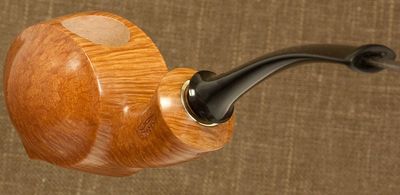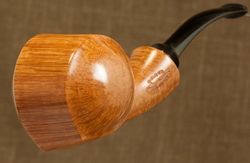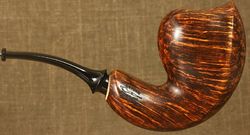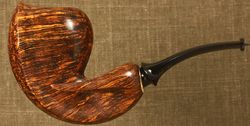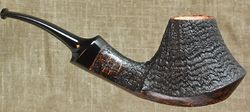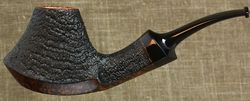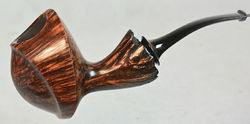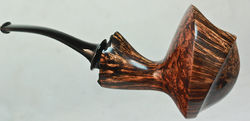Geiger Pipes
Love Geiger and Sara Mossberg make Geiger pipes. Love started making pipes 1997, with Sara joining him shortly thereafter as a pipe making partner. And yes, they are also husband and wife. Today they work together on everything from concept to their beautifully finished pipes.
Love and Sara have a relatively small production of very high quality pipes. Most have fanciful names that reflect their inspirations, and their stylistic designs are easily recognized. Their work sports thin and comfortable high quality hand cut ebonite stems, sometimes with Delrin tenons, but more-often using integral tenons, or stainless steel tenons for their bamboo pieces. Other accents can include bone, mammoth ivory, exotic woods, precious metals, and other unique and beautiful materials.
Two Minds Join as One. What you don’t know about Geiger pipes
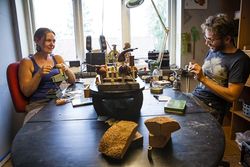
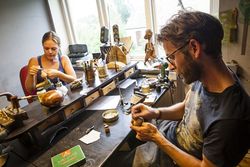
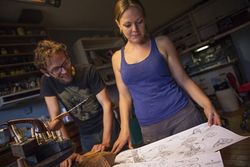
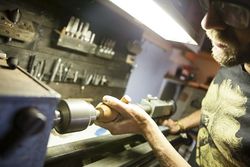
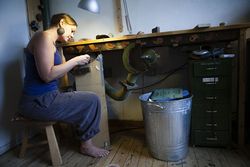
The following article and interview with Love and Sara is courtesy, David M of Tobaccodays.com, and is used by permission:
You may know that:
1. Geiger Pipes come from the country of Sweden.
-and-
2. That each Geiger Pipe is a product of the joint collaboration between the husband & wife duo, Love (pronounced Lou-Ve) & Sara.
What else do you know about Geiger pipes?…if in fact you even knew about both # 1 and # 2 above?
Here you have it, the deeper insight into what makes Geiger pipes tick.
Yes # 2 above is true. The pipe-making world has an absolutely genuine full-fledged, husband & wife team making world-class, high-grade pipes. The key words there were ‘husband, wife & high-grade pipes’. On the surface of that comment, one may tend to shrug their shoulders and say: “So what?, there are lot of two-person pipe-making teams in our hobby.” While that may very well be the case, I am not aware of any two-person teams out there who not only work together for 9 hours a day but also take their kids to school, clean and scrub the toilet & have romantic dinners together as well. For me, this ‘husband/wife’ team fact is an absolute ‘wow’. The ‘wow’ gets even bigger when you look at and understand, the amazing high level quality of the pipes that this married couple makes together.
Sara: “A strong trust between us has grown in the abilities of the other doing their utmost to succeed. Therefore if one of us screws something up in a pipe, we seldom get angry. This trust must also extend to letting each of us lead our specific areas of expertise.”
I guess for me, that thought of ‘married pipe-making couple’ highlights itself so much because of the common notions related to pretty much ‘all the immensely difficult things that one encounters when one is in a relationship’. Men are from Mars, Women are from Venus and so forth. Then my next thought is – How does one overcome those difficulties to the point of being able to produce elite class pipes together? How can a normal married couple possibly have the patience to work together so well? It simply amazes me how successful they are at doing this craft together. When I learned the details of their pipe-making process & how they make it all work, I was astounded even more. We will get to that shortly.
Let’s first briefly review who these people are so we understand how they approach pipes.
Love: “After working together for a while you start taking the pipes & our overall work together less personally. We realize that we are part of a team and these wonderful little pipe gems are the result of our collaboration. I think that most of us here in in the western part of the world get trapped up in our own ego’s and a very linear type of thinking. Because of that, we end up forgetting the source of some of our greatest achievements. Most great things come from more than just one person. Other people and their energies have always helped move things forward in inspiring ways.”
Love (again, pronounced Lou-Ve. Visualize a Swedish Louie only with a hard Ve at the end. Or say the famous Paris museum Louvre, minus the R and now you’ve got it) is the original member of Geiger pipes. In the mid-90’s Love’s appreciation for pipes started to take a hold of him and he began to immerse himself into it’s world. Sara was not a part of the process at the beginning. Love was the one taking the first curious steps into the pipe world. Every single detail about pipes interested him. His personality is so ‘excessive’ that when he enjoys something, he literally immerses his entire being into the subject matter & focuses on nothing else. So with pipes, every single detail interests him. He can discuss any minute pipe detail for hours on end, covering each possible angle & reviewing every potential positive or negative impact that comes from working a pipe in one way or another. The bookish & deep pipe wisdom in this duo resides within him. Love actually refers to himself as a full-fledged pipe-geek & he says it with the biggest smile on his face. It is quite naturally so. Love has been learning & working with briar for a good 20 years now.
Love: “Given the nature of briar what is most interesting to me is what that specific piece of briar will allow. We are always trying to optimize whats within the briar rather than forcing an idea onto it. Sometimes the results from having to work out a flaw in the briar will yield interesting new variations that force us into new and exciting territory. Since I am the more technical of the two of us, I have to take the drilling and functional aspects of the pipe into consideration.”
The Geiger Pipes business uses the following tagline to describe their pipe-making work – CLASSICAL INNOVATION. The bulk of the ‘Classical’ portion of those two words clearly hangs out within Love.
Love was initially drawn towards the Classical pipe designs. Not the English Classical design but rather the Danish & Scandinavian Classical design. Love has spent time with all the Danish and Swedish pipe masters & artisans. When you look at any Geiger pipe, no matter how innovative a shape it may be, you can always see that it is grounded within a Sixten Ivarsson’esque design philosophy. That portion of any Geiger pipe, will mostly come courtesy of Love. Although firmly rooted within the classic pipe design foundation, Love’s pipe mind has definitely had room for more than just Classical wisdom and he discovered this upon his first look at one Trever Talbert’s unique creations. The American artisan Trever Talbert exposed Love to the other side of the pipes, the creative side & Love fully appreciates that part of the hobby as well.
Love: “If you care too much about the normal pipe ideas, then the future of pipe-making will be really boring. Its always nice to challenge yourself to look at a shape and ask yourself – what more can I do? At the same time, we have to find a balance between being able to sell a pipe that someone wants to buy.”
Sara on the other hand, became the other half of Geiger Pipes about 10 years ago. Sara had always been interested in art. She studied art & artistic concepts at great length prior to joining her husband in the shop. Sara has an incredibly creative drive & a deep artistic spirit. Prior to her jump into pipes, she was searching for a medium to allow the artistic side of her to express itself in. Thankfully for fans of Geiger Pipes, she met a block of briar and started her career in pipes.
Sara: “When it come to pipes, I guess not taking yoruself too seriously & finding a way to have fun, in a professional way of course, is something I bring to the table. I also don’t always guess on what shape will be popular and I dare myself to venture into new territory and to explore and learn, even if it sometimes the results turn into nothing. We apply this philosophy to our day to day lives as well.”
Going into the pipe-shop however, to work with her husband no less, was not some sort of pre-defined plan. As is common in both of the Geiger’s personal philosophies on approaching life, Sara’s journey into the shop was an organic one and it evolved naturally & curiously. In fact as she tells me, not only did pipe-making provide her a creative outlet for artistic expression but there was actually an emotional pull into the shop as well. Sara felt very deeply that for the couple to have a successful marriage/partnership, she should work on finding ways to spend more time with her husband. There was definitely an emotional pull that brought Sara into the pipe-making shop.
Sara’s pipe mind lies on the complete opposite side of the pipe spectrum from that of her husbands. Sara is absolutely not the pipe-geek that Love is. Love is the one who spends a lot of time both on the internet, learning about what is going on in the pipe-making world & talking to other pipe-makers extensively about pipes in general. Sara on the other hand, does not do anything of the sort. In fact it is safe to say that Sara actively stays away from the informational world of pipes. Sara does not spend time learning what is current in pipes nor has she focused much of her attention on the past of pipes. Sara has separated herself from common pipe world information.
Love: “Drilling some of Sara’s freehand shapes can be a real fun challenge.”
This act is not something intentional on Sara’s part. This is just her personality. Sara’s concept of creating art is that it should all come from within herself. It is a type of self-exploration approach to the artistic process. By ignoring what other people are doing, only then can she find out what she can actually do. A self-imposed trial and error system of learning & creating if you will. All wrapped up inside a very creative and talented mind. This natural barrier to the outside pipe-world has allowed Sara to keep her mind clear from other pipe-maker’s ideas so she can focus exclusively on her own.
Sara: “Slightly asymmetrical shapes can be misunderstood by some people but that idea is incorrect in my opinion. Angling the briar on one side a few degrees more than the other, in order to highlight the grain, this is a good thing. This is an organic approach to the organic material of briar.”
When we go back to the tagline again – CLASSICAL INNOVATION. The bulk of the ‘Innovation’ portion of those two words clearly resides in Sara.
Love: “Depending on what kind of pipe we are making ,when Sara is freehand shaping she concentrates on the grain without having a fixed idea of what the final shape will be. This is an interesting way of creating and a great way to come up with new stuff. To let the mind wander and allow inspiration to come from just following the grain. Although some monsters have been created this way it is necessary and it is something we learn from. The briar monsters end up staying in a closet of course. This way of free learning is what defines our pipes. Sometimes Sara will sit at the disk sander for hours, completely lost in the moment.”
There is however a balanced system that Geiger Pipes follows when making their briar. Divide & Conquer is a very apt way of describing this dynamic duo’s pipe-making process. Sara takes the lead in the shaping department and Love focuses on the technical elements such as drilling and engineering. The advantages of this division of labor are clearly seen in their work. Sara’s strength is in her ability to free-flow an assortment of ideas, unencumbered by traditional pipe shape design philosophy. This allows Sara to freely wander in any shape direction she chooses to go into. Sara’s part & strength in Geiger Pipes is especially seen when she is working on freehand pipes. It is because of her personality traits that I describe her process as a form of freedom freehand. Outside of needing to do the obvious adjustments to the block’s shape when a particular flaw is encountered, it is safe to say that when Sara is working in free-hand mode, she does not know where the work will end up.
The other important point in their pipe-making process is that Love is always by her side. Love is right there, ready to inject the immense amount of pipe wisdom he retains & he actively participates in the shaping process. You can say that Love puts on the hat of a Director during Sara’s shaping. Love reviews Sara’s free reign design and injects ideas that one could say come from both a collector’s point of view as well as a classical design perspective. This moment in their pipe-making process is what one could call the ‘grounding stage’. Ensuring that a pipe concept has actual legs to stand on and it does not end up in the abstract sculpture department of the Modern Art Museum.
Sara: “ Love always gives his input and he makes suggestions on what small changes to make. When I listen to him and initiate his recommendation, the pipe always gets better.”
This is an absolutely crucial step. Should Sara’s designs stray too far from certain ‘pipe infrastructure/pipe basic’s’ elements, Love will begin to suggest modifications to the design, in order to bring it more in line with his classical knowledge. This is the place where the duo quite literally conquers. The Geiger’s are using their individual strengths to the final product’s full advantage & the end-user / collector’s, absolutely wild-eyed pleasure.
Love: “If I was to design all the pipes on my own, they would be more boring. Sara’s ideas make Geiger pipes more interesting from an innovation perspective.”
The Geiger’s become the perfect example of team-work with each stunning high-grade pipe they produce. The process of letting go of their personal ego’s, for the greater good of the common goal, creating & selling sensationally impressive pipes is for me, the place where the master-piece of Geiger Pipes lies. Their democratic approach to the act of creation. It is their ‘secret sauce’ so to speak. To do this step effectively one has to have a lot of wisdom & clearly, these two have it.
I make it a point to only cover pipe-makers who have achieved the point in their careers when their work can begin to be classified. How does this occur? Quite simply. Once you begin to see a unique pattern in all of their work & that pattern becomes consistent, you can then begin to define them. No matter what shape a pipe-maker’s system decides to tackle, if they have come to the point of developing an internal method of expression, they have achieved their own vocabulary and they are now expressing the art on their own terms . My personal definition of Geiger Pipes is that they are some of the most experimental pipe-makers on the planet whose work remains fundamentally placed within a classical design foundation.
To illustrate better perhaps, this is very different from a Roger Wallenstein pipe for example, whom one could also describe as very experimental, yet his pipes are not relying so much on classical design philosophy.
There are no wrong definitions or right definitions being expressed. Nobody is better or worse than the other. Everyone is creating on their own terms and this is a beautiful and pleasantly dynamic environment. We simply have definitions which assist us in categorizing the pipe-maker’s work with the purpose of being able to explain what types of different elements reside within the pipes themselves.
No matter how many innovative & different pipe-makers this blog covers, the pipe industry today retains a very un-friendly view to ‘innovative pipes’. Our hobby is still rooted within very traditional & very conservative views on what a pipe should be. No matter how many ‘rebellious’ pipe-makers you read about on this blog’s pages, their cumulative work will pale in comparison to the work of more traditional pipe-makers.
I would wager to guess that for pipes costing less than $200, a full 90-95% of them are made in Classic English or Classic Danish shapes. With higher grade pipes costing $400 on up, the numbers are likely better but still, I imagine that ‘innovative or different’ shapes make-up less than 15-20% of the overall high-grade market. The shift however for higher figures can at the very least be seen more clearly now. Those %’s of innovative & different pipes are rising. It is my opinion that pipe-makers like the Geigers & specifically their approach to creating pipes, is in fact the future of pipe-making.
Love: “For us growing and keeping the learning and exploring moving forward is key. This is what makes the work feel alive and not stale and boring. That being said, just because we make a shape that has not been done before, does not make it automatically great. Our joint innovation is simply our collective collaboration. We are two different individuals and we both inspire each other & we are both inspired by the idea of being to transform each other’s ideas into something else. This is one of the best parts of working together. Getting to watch the natural evolution from our process, it truly is fascinating stuff.”
How many years from now will it be that pipe-collectors will actually buy at least 50% of their collections in these ‘new’ shape styles? I cannot say exactly but that day is coming. Those collectors that will and are leaning towards these new shapes & are open to learn more about them, they will be following and purchasing pipes similar to that of the Geigers. The best way to achieve this goal of enticing the ‘perhaps’ old collector, is to make pipes that find the right balance between old and new. Something that the Geiger’s are doing extremely well as of late.
Sara: “At the end of the day we both enjoy what we do and we focus on not being too hard on ourselves. Fear and doubt, which often creep into anybody’s mind, are not good drivers for moving things forward. We think it’s best when our crazy ideas get ventilated and out there. You have to have standards and we definitely do. We are also critical of our work and we use that as well but not to the point where it impacts our personal selves in a negative way and it begins to inhibit our growth. Both personally and in our work.”
When you look at the quality of their work. Their pipe production is not just a statement to the pipe-world of what two heads merging as one can create, also though, it is a testament to the personal philosophies they have. These personal ideals carry them through the entire process of collaborative pipe creation in the husband and wife environment. They have taken the task of working together to a whole new level. They are beyond the usual bickering & the senseless fighting and they now create magnificent pipes together, in as peaceful a harmony as a husband & wife making pipe duo can ever get.
Thank you to both the Geiger’s for sharing their incredible story. It was truly a pleasure to learn so many wonderful things about this incredible pipe-making duo. So much behind their story helps us understand both how their pipes are made & what they stand for. I will never look at a Geiger Pipe the same way again.
All of the incredible personal photos of The Geiger’s were shot by their talented friend Kate Visonj. Thank you so much Kate.
Older Articles
Note: The following articles are now dated, although they may still be of interest... --sethile (talk) 00:31, 20 November 2013 (UTC)
Pearls - Pipes
by Jan Andersson (Written Sept. 2003)
Do you know how old a Freshwater Pearl Mussel may be? Much older than we human beings, 250 years - and about one mussel in a thousand carries a pearl. It is nowadays only to be found in six small rivers in Sweden and one of them is called Vram River. That this mussel is still living healthy there we have to thank the chips-manufacturer OLW for. You may think I am joking, but that is a fact. So I have a suggestion to all consumers of chips: buy OLW next time, and a few cents from each bag will help to keep this small river healthy. And in that way you can eat the unhealthy chips with a good conscience, and that is a good thing, no? The main purpose for OLW is that the freshwater mussel shall survive, but the Vram River also has other assets; there are a lot of salmons and crayfish in that river.
All that I was told one of the first really hot days in July when I was visiting Årröd, a place in the middle of Scania with a great natural beauty. My purpose with this visit was not to learn as much as possible about this river (that was an extra plus), and even if I was looking for a circus-wagon, I did not intend to go to a circus performance. No, I was looking for that circus-wagon for another reason, and without too much trouble I found it on a meadow, not far from the earlier mentioned Vram River. On the outside the wagon looked rather shabby, but when I entered I found a comfortable and well equipped workshop. This is the working-place for the young Swedish pipe-maker Love Geiger.
Pipes in soapstone
Love Geiger made his first pipe in the middle of the last decade, but the material was not briar but soapstone. Love had just started smoking a pipe and for a young man with an interest in making things with his own hands, it was natural to try making a pipe for himself. The material at hand was pipestone. He made a few pipes for his own use and also some for his friends, but the pipes were not very good, they became extremely hot and were very fragile.
A few years later Love got a lot of vulcanite stems and a few blocks of briar from a friend. Love got excited and decided not to make any more pipes from soapstone. He looked for information about pipe-making on the internet and got in touch with the American pipe-maker Trever Talbert. This was the start of an extensive correspondence over the Atlantic Ocean. Love had a lot of questions and Trever Talbert was willingly sharing his experiences and knowledge with Love. In that way Love learned a lot and, as he says himself, he also learnt very much from all mistakes he made in the beginning.
I met Love for the first time about two years ago. He had just started making briar-pipes and one evening he paid me a visit and showed his first pipes. But since that visit much has happened.
A circus-wagon as a workshop
Love Geiger is living in a collective called “Moder Jord” (Mother Earth), started in the 70’s by his father (the gentleman who told me about the fresh water mussel). Here lives the entire Geiger family but also a lot of other people, more in the summer than in the winter period. As mentioned before the place is of great natural beauty and from what I understand, the people here are living in close connection to nature. They have a hydroelectric power station, a mill of their own, a lot of the wood used for heating is taken from their own property and they cultivate a lot of vegetables. As Love is very inspired by nature in designing his pipes, it is hard to imagine a more suitable surrounding for him to live and work in.
Last summer Love bought an old circus-wagon which he decided to fit up as a work-shop. He really has succeeded in this, it is spacious, all the necessary machinery and tools are there and it is indeed a very pleasant place. However he is not completely ready, there is one more room fit up and he is also planning to repair and paint the exterior of the wagon. It will certainly become a beauty even outside in due time. It is a pity that there is so little interest in pipes among common people these days, otherwise Love could have travelled around with his wagon to fairs and expos, selling his pipes and showing people how they were made.
During the fitting-up of his workshop, Love has several times been in contact with another Swedish pipemaker, Bengt Carlson, who has helped him to find suitable equipment, mainly the most costly thing, the lathe. And a lathe bought from a hardware store is not ready to be used for pipe-making. Some things must be changed and some complementary equipment must be made. Bengt has the right connections to have this done properly. I hope and believe that the connection between Bengt and Love will continue in the future.
Pipes treated with – alcohol
Today Love has about 70 blocks of briar of the highest quality in his workshop. All of these are from Corsica and stored for at least 3 years. But Love is not addicted to Corsican briar, he is willing to buy briar from any place around the Mediterranean Sea where he can find the best quality. Today I think this is a common view among pipe-makers - you buy the briar where the best quality is to be found. The earlier fixation to Corsican briar has disappeared. However, Love says that he wants to find older blocks and for the future, he wants all blocks to be at least 5 years old before he makes pipes of them.
So far, Love has mostly used vulcanite for his stems, but he also has a large supply of acrylic in different colours, which is used when he finds it suitable.
Most of Love’s pipes are in natural finish but they are treated in a rather special way. The pipe is put in 96% proof alcohol in which some tobacco has been dissolved. The pipe will darken a little and the grain will be more outstanding. It will also get a little piquant taste during the first pipe-fulls. But Love also has stains mixed by himself, used when he finds it appropriate.
The pipes are plain or rusticated. Love however has a strong desire to make sandblasting on his own and is searching for the necessary equipment. He has already tried with a sandblaster used for cars, and at my visit I saw a piped blasted this way. It was quite nice, but I realize it can not be done like that in the future - Love had to blast this single pipe for more than 4 hours.
Pipes with their own names
Love says it takes an average of 20 hours to make a pipe completely ready and he has no ambition to have a large production. The pipes are stamped with the logo seen in the beginning of this article. He has no grading system (at least not yet) but the pipes are priced 100 – 350 €.
Of course, all Love’s pipes are entirely made by hand and he has no lust or intention to copy shapes from other pipe-makers. Every single pipe has a name of its own and these names are often both witty and imaginative.
From Love's original website
My journey into pipemaking started back in 1997 at the age of 20. After being a pipesmoker for a few years I wanted to try making one myself, not at all being aware of the different materials used in pipemaking, I used soapstone instead of briar and had so much fun in the process that I started to make pipes for friends all around. The soapstone smoked hot and broke easily… As a present from a friend, I received a hundred ebonite stems and a piece of briar and I quickly fell in love. I came in contact with the American carver Trever Talbert (being a great fan of his work) over the net, and started mailing him frequently with different questions regarding the making of pipes, got what books were available on the subject and learned a lot from all my mistakes. The more I got into making pipes the more I wanted to do it to contribute to this outdying craft. My grandmother was a big fashion designer and I grew up with a stepfather who is a glassblower in Skagen so this comes pretty natural to me. The summer of 2002 I left the dusty unheated workshop, bought an old circus wagon and built my shop in it and invested in all the necessary machinery to do serious work: a bandsaw, a quality metal lathe and a beltsander. To learn the lathe I have been visiting Bengt Carlson and will continue doing so as I have such a good time being there.
The briar I carry is mostly the best Corsican plateaux dried for 3 years, but my goal is to have 5 years dried briar soon. The tb hole is often drilled with a 19 or 20 mm cylindrical or a 17mm conical drill and the airhole is drilled with a 4mm drill. I use a beltsander to rough shape my pipes and do the detailing work with a dremel hand drill with different carving heads.
The stems are made from high quality Italian ebonite blanks and colored acrylic (in the process of learning to handcut my own ebonit stems but will not sell till I'm satisfied with how they turn out) I work down the stems around the bite to 4 mm to make them comfortable to have in your mouth and reduce saliva. I spend many hours to get these to fit in harmony with the stummel. For shank extensions and stem rings, I use exotic woods like pockenholtz and masur birch, stabilized wood also use bone and mammoth tooth.
As of yet I have no grading system for my pipes, but price them in a range from 100-350 euro according to the grain, spots and sandpits and and after the grace of the shapes. The pipes are put in a mixture of 96% pure alcohol and tobacco juice to give them a base coloring and a little taste, therefore many of my pipes are "virgin" as I strive to give my customers as clean a smoke as possible. All pipes are stamped Love Geiger Sweden and are polished using only paraffin oil, Tripoli and carnauba wax. Last but not least a thin layer of carbon is added to protect the pipes from burnout's, this is a mild mixture that leaves very little taste to the smoke. The same as Bo Nordh, I put at least 20 hours of work into each pipe I make and strive to give customers good value for their money.
I consider myself a freehand maker first and foremost as no pipe I make is ever exactly the same,and most of my designs are uniquely my own. I do some classic work or my own interpretations thereof, but mostly like to be a little more daring. Living in the countryside my greatest inspiration is the grace of nature with all its shapes and forms. As I am still quite young and have many irons in the fire, music is also a great part of my life, friends and my girlfreind. But having life ahead of me I promise you many pipes to come. Pipes a year 60-??
Love Geiger
Offsite Links
- Fantastic article (used above) in its original form at Tobaccodays.com
- Excellent interview of Love and Sara by Shane Ireland at Smokingpipes.com
Contact information
Geiger Pipes Website Email: love@geigerpipes.com Telephone:+46 44351196 Adress: Geigerpipes Sockenv.474 S29795 Degeberga Sweden

